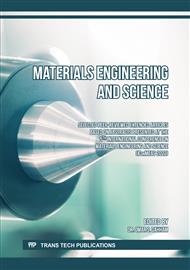[1]
H. Hsu, W. Zhong, Nanocellulose-Based Conductive Membranes for Free-Standing Supercapacitors: A Review, Membranes, 9 (2019) 74.
DOI: 10.3390/membranes9060074
Google Scholar
[2]
Y. Habibi, L. Lucia, O. Rojas, Cellulose Nanocrystals: Chemistry, Self-Assembly, and Applications, Chem.Rev. 110 (2010) 3479-3500.
DOI: 10.1021/cr900339w
Google Scholar
[3]
B. Thomas, M. Raj, B. Athira, H. Rubiyah, J. Jithin, A. Moores, G. Drisko, C. Sanchez, Nanocellulose, a Versatile Green Platform: from Biosources to Materials and their applications, Chem. Rev. 118 (2018) 11575-11625.
DOI: 10.1021/acs.chemrev.7b00627
Google Scholar
[4]
W. Chen, H. Yu, S.Y. Lee, T. Wei, J. Li, Z. Fan, Nanocellulose: A promising nanomaterial for advanced electrochemical energy storage, Chem Soc Rev 47 (2018) 2837.
DOI: 10.1039/c7cs00790f
Google Scholar
[5]
R. Rinaldi, F. Schuth, Design solid catalysts for the version of biomass., Energy Environ Sci 2(6) (2009) 610.
Google Scholar
[6]
M. Asrofi, H. Abral, A. Kasim, A. Pratoto, M. Mahardika, J.W. Park, H.J. Kim, XRD and FTIR Studies of Nanocrystalline Cellulose from Water Hyacinth (Eichhornia crassipes) Fiber, Journal of Metastable and Nanocrystalline Materials, Vol. 29 (2017) 9-16.
DOI: 10.4028/www.scientific.net/jmnm.29.9
Google Scholar
[7]
D. Klemm, B. Heublein, H.P. Fink, A.Bohn, Agnew. Chem. Int. Ed., 44 (2005), 3358-3393.
DOI: 10.1002/anie.200460587
Google Scholar
[8]
M. Balat, G. Ayar,Energy Sources, 27 (2005), 931-940.
Google Scholar
[9]
R. Ruiz-Palmero, M.L. Soriano, M. Valcárel, Sulfonated nanocellulose for the efficient dispersive micro solid-phase extraction and determination of silver nanoparticles in food products, Journal of Chromatography A, CHROMA-356581 (2015) 7.
DOI: 10.1016/j.chroma.2015.06.023
Google Scholar
[10]
A.F. Abdel-Fattah, M.A. Abdel-Naby, Pretreatment and enzymic saccharification of water hyacinth cellulose; Carbohydr. Polym., 58 (2014) 125-129.
DOI: 10.1016/j.carbpol.2011.10.033
Google Scholar
[11]
M.T. Sundari, A. Ramesh, Isolation and characterization of cellulose from the aquatic weed water hyacinth-Eicchornia crassipes, Carbohydrate Polymer, 87 (2012) 1701-1705.
DOI: 10.1016/j.carbpol.2011.09.076
Google Scholar
[12]
J.X. Sun, X.F. Sun, H. Zhao, R.C. Sun, Isolation and characterization of cellulose from sugarcane bagasse, Polymer Degradation and Stability, 84 (2004) 331-339.
DOI: 10.1016/j.polymdegradstab.2004.02.008
Google Scholar
[13]
E. De Morais Texeira, T.J. Bondancia, K.B. Teodoro, A.N. Corrêa, J.M. Marconcini, L.H. Mattoso, Sugarcane bagasse whiskers: Extraction and Characterization, Industrial Crops and Products, 33 (2011) 63-66.
DOI: 10.1016/j.indcrop.2010.08.009
Google Scholar
[14]
L.D. Whittig, W.R. Allardice, X-Ray Diffraction Techniques, University of California, (1986).
Google Scholar
[15]
S. Tanpichai, S.K. Biswas, S. Witayakran, H. Yano, Water Hyacinth: A Sustainable Lignin-Poor Cellulose Source for the Production of Cellulose Nanofibers, ACS Sustainable Chemistry Engineering, (2019).
DOI: 10.1021/acssuschemeng.9b04095
Google Scholar



